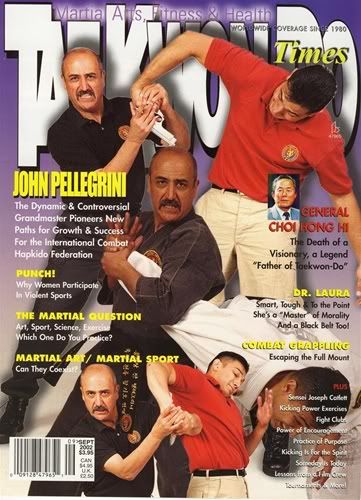INTERNATIONAL COMBAT HAPKIDO FEDERATION
Kwan of the
World Kido Federation
Modern Punch Defenses of Hapkido
Author: Luke Fraser
What is it about defending against punches that oftentimes causes martial artists to question their abilities? If you were to ask the average new student what aspect of self-defense he or she would most like to learn, the majority would respond with punch defenses. Why is this the case? It's simple: Throwing a punch, a slap or any sort of hand attack is one of the first lines of offense or defense that we learn as children, and usually the first method of attack we see when exposed to some form of violence. Children become familiar with hand attacks early in life; whether it is seen in a movie, in a fight on the playground, or in domestic abuse a situation that far too many children are being exposed to today.
As we grow older and the possibility of actually being attacked becomes more realistic, the thought of being struck by a larger individual is one of the most highly feared occurrences for the average person. However, it does differ a bit between the sexes. Men are conventionally those whom concern themselves more with the punching aspect of a street attack whereas women mostly fear a rape or abduction by a larger man. What most women don't always consider is the fact that strikes often accompany a rapist's arsenal when he carries out his assault.
This article will cover the most effective and useful defensive methods that the average man or woman can use to quickly and easily prevent an assailant from achieving his goal of landing that big knockout punch. The style known as Chon Tu Kwan or Combat Hapkido, founded and created by Grandmaster John Pellegrini, has some of the most practical methods for disabling an attacker who has thrown a punch.
Unlike many forms of traditional martial arts, Combat Hapkido employs a unique scientific ideology for defending against a fist. First and foremost, it is paramount to differentiate between the different types of hand attacks. Second, a practitioner of Combat Hapkido must study which attacks are most widely used in a real street attack and; third, how is the attack delivered and from what distance.
Oftentimes, some martial arts instructors will teach punch defense from a traditional front stance and then lunge in with a basic straight punch. While this may seem useful to some, quite simply, it is not practical and will cause a student to develop a false sense of security. Take a moment to think about the fights you may have seen in your lifetime. A punch is almost always thrown in rapid succession no more than an arm's distance away. Self-defense training also must be practiced in a similar fashion to simulate reality.
So what then are the most common types of punching attacks one is most likely to encounter on the street? There are three. Let's explore each one individually.
The Cross or Straight Reverse Punch:
The straight punch, whether with the front or rear hand, will always be the most difficult punch to defend against. As we have all learned, the shortest distance between two points is a straight line. Therefore, it will always be more difficult and we will always have less time to react when this attack is launched.
There are many contributing factors that will determine whether or not you'll be able to defend yourself properly against a cross or straight reverse punch. The first, and possibly most important, is the positioning and placement of the hands. If you are a fan of boxing, you have probably noticed that the majority of knockouts occur when a fighter is hit along the jaw line (area from the ear lobes to the middle of the chin). Knowing this about knockouts should be a practitioner's first clue as to where to position hands when expecting a punch. Combat Hapkido remains consistent about keeping the hands open rather that closed: it is simpler to trap an opponent's arm and construct some sort of counter if the hands remain open. Also, palm strikes, Ki-strikes and other open-hand counters are greatly preferred by the Combat Hapkido stylist.
Once proper hand position is established, the next consideration is to ascertain a rule regarding straight punches. It is this writer's firm belief that the best method of defending against a straight punch is to use your corresponding hand to parry the attack in accordance with "side to side" head movements. Explained a little differently, if an attacker punches with the right hand, do not attempt to cross over and block with your right hand but instead use your left, or corresponding, hand to parry. However, that parry is not enough. Additionally, you must move your head to the outside of your attacker's body in a simultaneous motion with your parry. The combination of those two body movements creates the most efficient method for defending against the straight cross punch. Once the assailant's punch has been redirected, the Combat Hapkido stylist would then proceed to apply one of many joint locks, choke holds or takedowns to finish off his opponent.
The Drunken or Wild Hook Punch:
Unlike the cross punch, a hook punch, although quite intimidating at times, can be defended against with a bit more ease due to the circular motion of the attack. This motion allows a split-second extra time to react and begin an effective counterattack. In a traditional form of Hapkido as well as numerous other styles, it is often stressed that to successfully defend against a hooking type of attack one must continue in the direction of the attack and not meet force with force. In Korean art forms, this is called the "Won" or Circular Principle. Combat Hapkido also employs this principle in many of its punching defense requirements but in accordance with them, it also utilizes various other methods as well.
A drunken or wild hook punch is often dismissed as an ineffective method of attack. This is not only incorrect but also dangerous to even think that it could not cause injury! Although this form of punching may not be as damaging as a properly executed boxing style hook, if it should find its mark on your chin, its effects could be devastating. To remain prepared to defend against this punch, your hand position should not differ from that of the cross-punch. Your hands should remain open, relaxed and be placed in a position that will protect the jaw line.
Defending against the hook is different than the cross in another way: Because you have more reaction time, you may be able to use your cross-hand to parry this attack. However, I highly stress that you find a defensive tactic that will allow use of the corresponding hand rather than attempt to cross over and block. If you must cross the body, it is recommended that you learn to use a two-hand parry rather than simply a hard style block.
The lower half of the body also plays an intricate part in complete defense. Proper footwork used in conjunction with parrying may decide whether or not your defense is successful. In Combat Hapkido, practitioners never use deep traditional stances or commit fully to one body posture. One must keep the feet positioned in close proximity and never place them in a position where they are uncomfortable and can't be easily moved. Proper footwork is a boxer's best friend and as martial artists, we need to adopt the boxer's mind-set as far as leg mobility is concerned. The two most common types of movement when defending against wild hook punches are to side step and dip or to utilize a circular principle counter. Both methods are displayed.
The Uppercut Punch:
The third and most neglected punch that should be studied by all self-defense practitioners is the upper-cut. The previous two punches are taught by most respectable martial arts instructors but oftentimes the uppercut is omitted and never discussed. This is an injustice to serious martial arts students because this form of attack is all too common. Once again, there is a very different approach to this self-defense. Almost 100 percent of the time, an uppercut will be thrown from one position only: when in very close quarters with an attacker who is able to sneak it in underneath your guard. It is because of its elusiveness that the uppercut, if thrown correctly, is sometimes difficult to predict and may cause difficulty.
Combat Hapkido employs two methods of defense when dealing with an uppercut punch attack. First, your ready posture will remain the same but also must protect your mid-section. Simply keeping your elbows close to the body should enable you to keep the punch from squarely hitting its primary targets. What then is the target of an uppercut? There are many. The two most devastating spots to be struck by an uppercut are the chin and the solar plexus. Yes, the ribs and kidneys are also areas where you should be cautious but the chin and solar plexus are an attacker's key focal points. The Combat Hapkido method again is based on simple and effective movements rather than an elaborate strategy of fancy techniques which will probably render you confused and tangled up in your own arms! (Two effective and simple methods for defense are demonstrated.)
Conclusion:
There are many factors to consider when training to defend against punches, all of which can change the outcome of the attack. There is a science behind properly executing a successful counter to a well-thrown punch and the road to its proficiency is a long one. Timing, rhythm and an overall fluidity of motion all come into play. As with all defensive tactics, you must train your body to remain loose and relaxed in order to allow for any of the techniques explained in this article to be effective.
How do you become more proficient? The answer is to begin practicing in a more realistic manner and to ask yourself how you would attack if you were to throw a punch. Then begin drilling with a partner making sure that you remain in a realistic position and with very little distance between you and your training partner. If you train in an impractical way, your chances of defending against a surprise attack are very slim. So, keep it realistic and you'll be on the path to a more practical method to your punch defense arsenal.
This article originally appeared in http://martialarm.blogspot.com/












